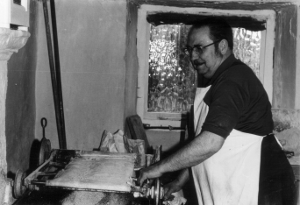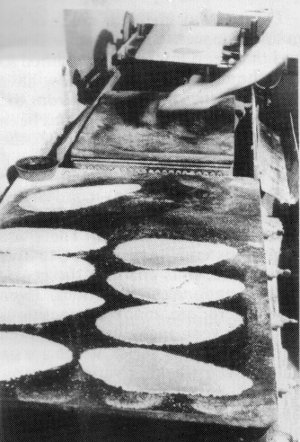Back in 2005 I made a blog
post about my hunt for Lancashire Oatcakes in the style I remember from my
childhood. The closest I was able to get was a recipe for Staffordshire
Oatcakes.
I tried that recipe, but it wasn't right. I tried
modifications, but failed. My family began to tease me about my various efforts
and failures.
Well, fast-forward to 2013 and the content of the Internet
has greatly expanded.
First, there is a Wikipedia Oatcakes entry. As I
noted earlier, there are distinct regional differences. Currently the article
describes:
- Scottish oatcakes
- North Staffordshire and Derbyshire oatcakes – two very closely related
- Lancashire oatcakes
- Canadian oatcakes
While Lancashire oatcakes are mentioned, there is no recipe.
However, it does say they are: “...made
without wheat flour or milk, and shaped as an approximate 11-by-6-inch
(28 cm × 15 cm) oval, smooth on one side and rough on the other…”
The physical description is exactly as I remember. The lack of wheat flour and
milk clearly makes a big difference and explains why the Staffordshire oatcake
recipes were not what I was looking for. On the plus side, the fact that there is
no wheat is ideal as some members of my family need to avoid wheat gluten.
But where to find a recipe for the Lancashire style?
The Internet came to the rescue again. Now I have found this
recipe:
Ingredients:
- 450g fine oatmeal (you can grind regular oatmeal in a food processor if you wish)
- 2 tsp. instant, dried, yeast
- 2 tsp. sugar
- 2 tsp. salt
- 1 dessert spoon oil
- 1.5l warm water (about)
Method:
Combine the oatmeal, yeast, sugar,
salt and oil in a large bowl.
Form a well in the centre and add
just over half the water. Stir to combine then keep adding water until you have
a pancake-like batter.
Heat and lightly oil a frying pan
then add 1 cup of the batter and cook for about 4 minutes per side.
Set aside to cool as you finish
cooking the remaining batter. Either use immediately or dry to make 'hard'.
These oatcakes will keep in the refrigerator for several days and freeze well.
The results have been quite good, but not perfect yet. In particular
the appearance is wrong. Details of preparation seem to make a big difference.
The oatmeal needs to be ground very fine – the finer the
better I have found. I use a kitchen machine on a high grind setting for a
minute or so.
The recipe calls for yeast, but there is no mention of
letting it sit first. Most recently I did so for two hours at room temperature,
which seemed beneficial. Overnight in a refrigerator might be even better. I
will have to experiment.
Then there is temperature. At first I tried cooking as I
would a traditional crepe, but the oatcake never seemed to brown properly. I realized
that crepes are cooked at a comparatively low temperature because of the milk
and eggs in them – both of which burn easily. I had much greater success with a
higher temperature; if fact, a very high temperature.
An important distinction of Lancashire oatcakes is that they
are smooth on one side, and bubbly on the other. Reference is made to using a
cast iron griddle or hot stone, not a modern non-stick frying pan of course.
Significant mass to resist cooling as the batter is added should help.
So I was really pleased when I found pictures of the
traditional Lancashire oatcake cooking process. www.oatcakebaker.co.uk is a gold mine
on the subject:
“This
site is about the Holroyd family hotplate bakehouse located at 6 Barkerhouse
Road, Nelson, Lancashire, UK which made oatcakes, crumpets, pikelets and
muffins between 1909 and 1984… The information included in this site is largely
from the family albums and scrapbooks.”
A key element was an ‘oatcake throwing machine,’ patented in
the 19th century. It is this device that creates the characteristic elongated
shape, and which deals with the tricky issue of spreading the batter in a thin
and uniform layer before it is placed on a very hot, hotplate with a shellac
surface (to prevent sticking).
After the first side is cooked (the side that is smooth), “The oatcake is scraped off the face with a
flexible knife about 40cm long by 5cm wide picked up by hand and transferred to
the second hotplate.” This second plate is cooler, and the oatcakes appear
to be left on it longer as there are 8-10 on it while there is only one on the
first plate at any time.
Reference to the large flexible knife or spatula solves
another issue I found. The oatcakes are very fragile while they are cooking.
Much more so than pancakes and crepes made with wheat – gluten helps bind them.
So I have some more experimenting to do, but I think I’m on
the right track. The good news is that my family likes the recent results well
enough to eat them now.

